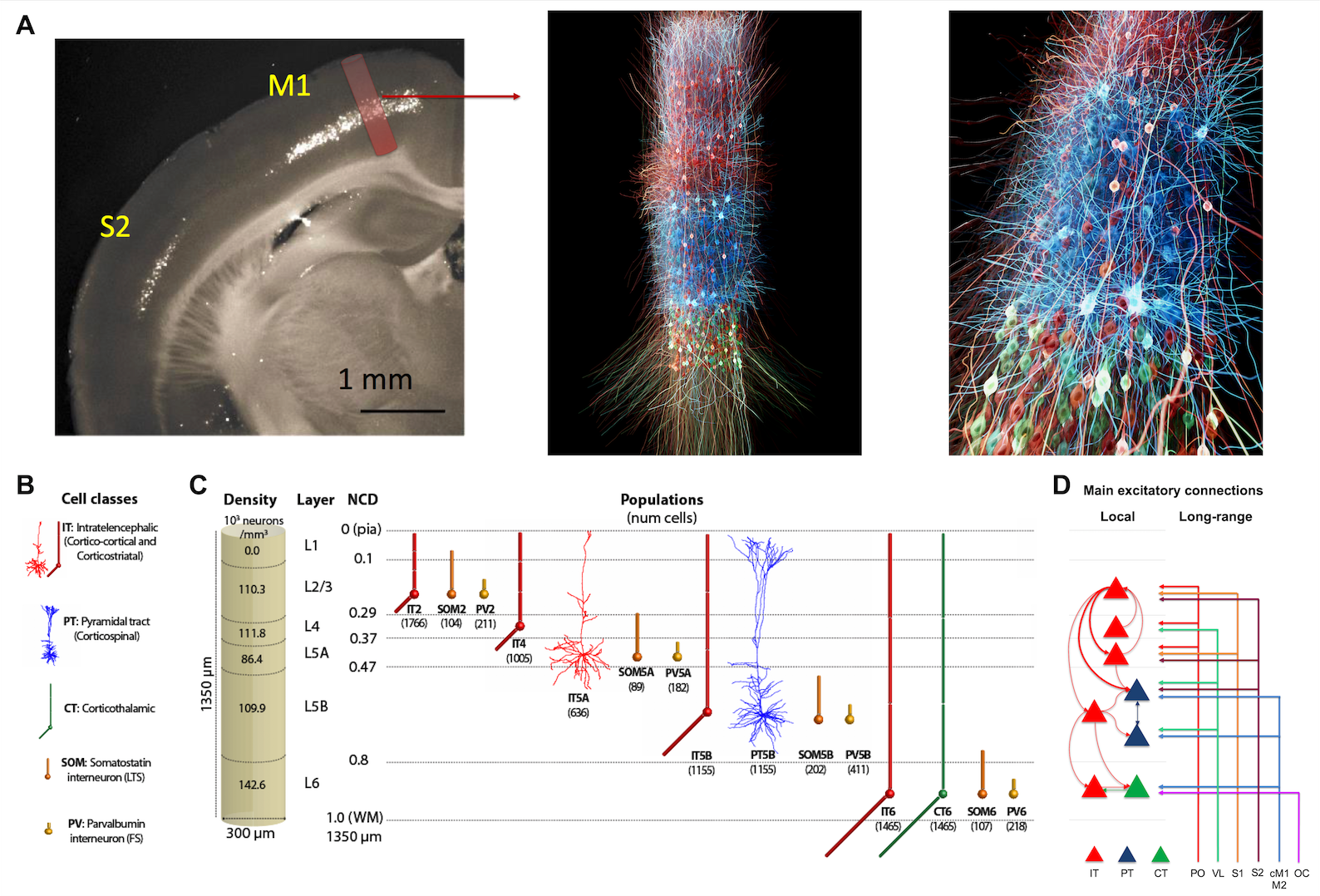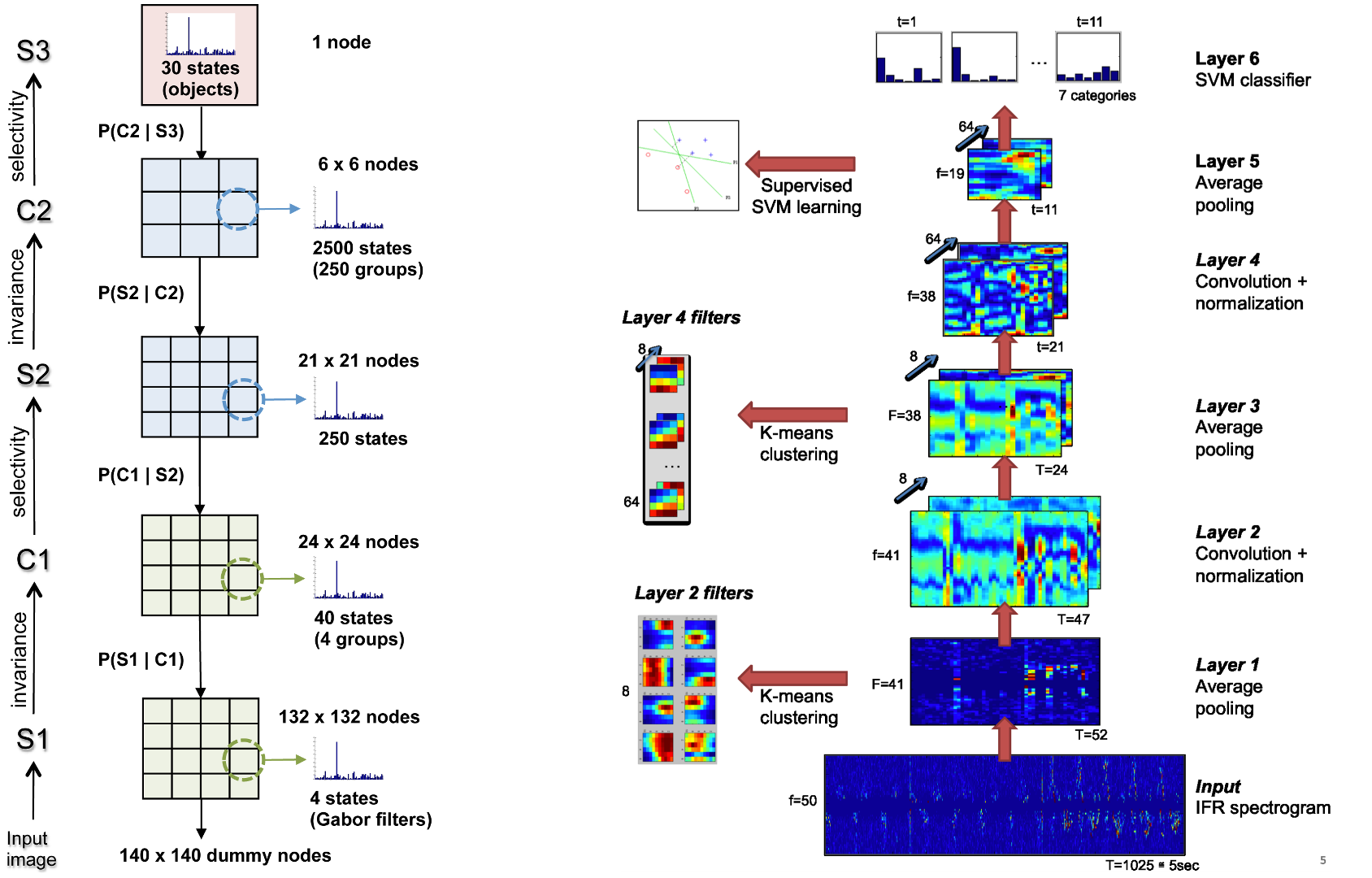
Multiscale Modeling of Brain Circuits

From molecules to behavior
We integrate experimental data into detailed models to study the interactions across scales (molecular, cellular, circuit and behavior) and their role in brain function and disease. For example, how the interactions between long-range thalamocortical inputs and noradrenergic modulation of HCN current regulates M1 dynamics associated with behavior.
Dura-Bernal S, Neymotin SA, Suter BA, Dacre J, Moreira JVS, Urdapilleta, Schiemann J, Duguid I, Shepherd GMG, Lytton WW (2023) Multiscale model of primary motor cortex circuits reproduces in vivo cell type-specific dynamics associated with behavior. Cell Reports 2023 Jun 8;42(6):112574.
Borges F, Moreira J, Takarabe LM, Lytton WW, Dura-Bernal S. (2022) Large-scale biophysically detailed model of somatosensory thalamocortical circuits in NetPyNE. Frontiers in Neuroinformatics, 10.3389/fninf.2022.884245
NetPyNE: a tool for data-driven multiscale modeling of brain circuits. (2019) eLife 2019;8:e44494
Computer modeling for pharmacological treatments for dystonia. (2017) Drug Discovery Today: Disease Models, 19:51-57.

Neural coding mechanisms
We use models to identify and characterize neural coding mechanisms within and across scales, including synchronous firing of neuronal ensembles, phase-amplitude oscillatory coupling, dendritic and network resonance, neuromodulatory interactions (e.g. noradrenaline and dopamine), neuronal avalanaches, and information flow.
Local Glutamate-Mediated Dendritic Plateau Potentials Change the State of the Cortical Pyramidal Neuron (2020) Journal of Neurophysiology (In Press).
NetPyNE implementation and rescaling of the Potjans-Diesmann cortical microcircuit model. (2020) arXiv:2005.03764. Under Review in Neural Computation.
Effects of Ih and TASK-like shunting current on dendritic impedance in layer 5 pyramidal-tract neurons (2020) BioRxiv 10.1101/2021.01.08.425962.

Motor cortex circuits
We developed a model of mouse primary motor cortex circuits containing over 10,000 biophysically and morphologically realistic neurons and 30 million synapses, with neuronal density, distribution and synaptic connectivity patterns derived from experimental data; and validated different cell type-specific dynamics associated with behavior against in vivo data.
Multiscale dynamics and information flow in a data-driven model of the primary motor cortex microcircuit (2019) bioRxiv, 201707 [Preprint]
Optimizing computer models of corticospinal neurons to replicate in vitro dynamics. (2017) Journal of Neurophysiology, 117(1):148-162.
Simulating large-scale models of brain neuronal circuits using Google Cloud Platform. (2020) Practice and Experience in Advanced Research Computing, PEARC2020. 10.1145/3311790.3399621

Auditory thalamocortical circuits
In collaboration with the Nathan Kline Institute, we built a biologically-detailed model of macaque auditory thalamocortical circuits, receiving auditory input from a model of cochlea and inferior colliculus, to investigate the mechanistic origins of spatiotemporal oscillatory patterns observed in vivo. Preliminary simulation results matched in vivo macaque firing rates and LFP/CSD oscillations.
Biophysically-detailed multiscale model of macaque auditory thalamocortical circuits reproduces physiological oscillations. (2020) Computational Neuroscience (CNS), 2020.
Data-driven model of auditory thalamocortical system rhythms. (2020) Society for Neuroscience (SfN), 2019.
Taxonomy of neural oscillation events in primate auditory cortex. (2020) bioRxiv, 2020.04.16.045021[Preprint]. Under review in PLoS Biology
Software Tools for Modeling

NetPyNE: a tool for multiscale modeling of brain circuits
NetPyNE is an open-source Python package to facilitate the development, simulation, parallelization, analysis, and optimization of biological neuronal networks using the NEURON simulator. It includes a state-of-the-art graphical user interface developed in collaboration with MetaCell. More info at www.netpyne.org
NetPyNE: a tool for data-driven multiscale modeling of brain circuits. eLife 2019;8:e44494
Simulation neurotechnologies for advancing brain research: Parallelizing large networks in NEURON. (2016) Neural Computation, 28:2063-2090.
Simulating large-scale models of brain neuronal circuits using Google Cloud Platform. (2020) Practice and Experience in Advanced Research Computing, PEARC2020. 10.1145/3311790.3399621

Collaborations with other tools and resources
We collaborate with multiple other groups in the development of tools, resources and standards to advance computational neuroscience, including OpenSourceBrain, NeuroML, SONATA, Geppetto, Human Neocortical Neurosolver, Neuroscience Gateway, E-BRAINS, coreNEURON, SciDash and The Virtual Brain.
The SONATA Data Format for Efficient Description of Large-Scale Network Models. (2019) PLOS Computational Biology 16(2): e1007696.
Open Source Brain: a collaborative resource for visualizing, analyzing, simulating and developing standardized models of neurons and circuits. (2019) Neuron, 10.1016/j.neuron.2019.05.019.
Geppetto: a reusable modular open platform for exploring neuroscience data and models. (2018) Philos. Trans. Royal Soc. B 373: 20170380.
Machine Learning for Neuroscience

Optimization and analysis of detailed cortical models
We use machine learning to analyze the neural model structure and simulation output (e.g. clustering of neuronal avalanches) and to automatically optimize the model parameters to reproduce experimental data (e.g. via genetic/evolutionary algorithms).
Integrating Machine Learning and Multiscale Modeling: Perspectives, Challenges, and Opportunities in the Biological, Biomedical, and Behavioral Sciences. (2019) Nature Partner Journals (npj) Digital Medicine, 2, 115.
Multiscale modeling meets machine learning: What can we learn? (2019) Archives of Computational Methods in Engineering. DOI: s11831-020-09405-5
Optimization by Adaptive Stochastic Descent. (2018) PLoS ONE, 13(3):e0192944

Deep learning models of cortical systems
We develop deep learning models, including convolutional networks and Bayesian networks with belief propagation, to better understand the function of circuits underlying sensory perception. Models are based on anatomical and physiological experimental data and reproduce features of visual and auditory cortex dynamics.
Top-Down Feedback in an HMAX-Like Cortical Model of Object Perception Based on Hierarchical Bayesian Networks and Belief Propagation. (2012) PLoS ONE, 7(11):e48216.
Multimodal integration of micro-Doppler sonar and auditory signals for behaviour classification with convolutional networks. (2013) International Journal of Neural Systems, 23:1350021.
Neurocomputational Models of Perceptual Organization. (2010) Unconscious memory representation in perception: Processes and mechanisms in the brain, In: Advances in Consciousness Research 78,Chapter 6. pp 147-177
Biomimetic Neuroprosthetics

Brain-machine interfaces
We develop biomimetic brain-machine interfaces based on realistic cortical cortical spiking models that can interact directly with the biological neurons and with a robotic/virtual arm in real time. The system could be used to decode the patient's brain signals through a more biological approach, exploiting plasticity and adaption, and could potentially replace damaged brain regions with in silico counterparts.
Evolutionary algorithm optimization of biological learning parameters in a biomimetic neuroprosthesis. (2017) IBM Journal of Research and Development (Comp. Neuro. special issue), 61:2/3.
Cortical spiking network interfaced with virtual musculoskeletal arm and robotic arm. (2016) Frontiers in Neurorobotics, 9:13.

Neurostimulation
We use our multiscale brain models to simulate the effects of neurostimulation (e.g. electrical or optogenetic) on neural circuits, and help predict the stimulation patterns required to alter network dynamics and restore healthy function for different brain lesions or disorders.
Restoring behavior via inverse controller in a lesioned cortical spiking model driving a virtual arm. (2016) Frontiers in Neuroscience (Neuroprosthetics), 10:28.
Towards real-time communication between in vivo neurophysiological data sources and simulator-based brain biomimetic models. (2014) Journal of Computational Surgery, 3:12.
For additional research projects see also ongoing research collaborations.


